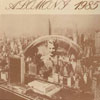 Possibly deemed too weird to exist upon its original release in the late 1970s, this mysterious LP has been given a second chance in a more modern world with this limited release, surely motivated by Julian Cope’s outspoken love of it. Some 30 years later, this CD issue is still a difficult prospect, combining early krautrock experimentations, brain-damaging blues forays, and a healthy dose of surrealistic psychedelia.
Possibly deemed too weird to exist upon its original release in the late 1970s, this mysterious LP has been given a second chance in a more modern world with this limited release, surely motivated by Julian Cope’s outspoken love of it. Some 30 years later, this CD issue is still a difficult prospect, combining early krautrock experimentations, brain-damaging blues forays, and a healthy dose of surrealistic psychedelia.
Phoenix Records
The presentation of this reissue intentionally retains all of the originals mystery: none of the musicians are credited (and may remain unknown to this day), and the full color reproduction of the original LP insert is a simple white/pink gradient painting. The disc is structured like the original vinyl LP as well, with two side-long tracks that are untitled.
The first side is essentially a collection of four tracks combined into one, with noticeable stop/start points. Although eschewing the drums for the most part, the side opens with junky percussive sounds and a twangy, meowing cat guitar line that eventually joins multitracked chanting vocals and an apocalyptic harmonica solo. While on the surface this sounds rather unhinged, it is in fact the most traditionalist segment of this entire album.
The music then morphs into noiser territory, with treated tape-loops and vocals being shouted from an intercom somewhere in the room. At this point, the music, accented with the shrill horn solo and pitch bent guitar, seems like a band who took Can's "Aumgn" and "Peking-O" as their raison d’etre. The remaining segments focus on the backwards loops and bleak soundscape elements, alternating between ritualistic and raw, aggressive vocals.
The second side is a more consistent dynamic throughout. The initial sound collages, grimy bass thump and anemic horns give it more than just a passing resemblance to the earliest recordings of Cabaret Voltaire, and occasional awkward stabs of funk solidify this even more. Eventually the music crosses into more conventional rock sounds, but with a distinctly Eastern feel, but it soon dissolves back into freeform vocals and backward tape loops, closing with the abstraction it began with.
Hearing this album some 30ish years since its initial release, it is still a baffling, head-scratching disc. It isn’t difficult to hear the influences of their German forefathers, nor is it difficult to see how the likes of Fushitsusha were born of this chaos. While the various practitioners of so-called "experimental" music that have come and gone since this first was released have made it a bit less left-field than when it was first released, it has lost none of its impact.
samples:
Read More

